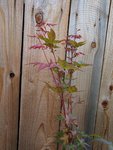I realize I am a week late here, have you already taken your cuttings? how are they doing?
Any thoughts on when to take these -- do you agree these are still too soft?
I was taught to use the 'snap test'. When you bend a branch, if it 'snaps' as opposed to folding, creasing, collapsing, etc., they are ready! I perform this test in the middle of a branch that is about 7-10 internodes long
That said, when you perform the test the internodes near the tip of the branch will not 'snap', and the internodes near the base will be tougher to snap. nonetheless, if you are getting 'snapping' near the middle of the branch, you can use as cuttings the base, middle, and tip! See picture #7 in post #334:
What species do you have available as natives there? I only have one in my area Acer glabrum. I have a couple, one has enough going for it as raw material that it may work out but also has enough against it that it may not. There is good material out there in the hills but very rare. Hope...

www.bonsainut.com
All of the literature seems to be on taking cuttings from the first flush
as
@0soyoung said above, second flush can work very well. I have success with second flush using arakawa, kashima, and kiyo hime.
However--and I cannot explain this in terms of plant biology--some cultivars can only be done using the first flush. In my experience and based on what I was taught, these are also the cultivars (perhaps it is not a coincidence) for which it is important to use young plants. (i.e. for some cultivars, cuttings from a 10 or 15 year old specimen will not succeed at the same rate [or at all] as they would from a 3-5 year old specimen). I can confirm that Katsura and Shin Deshojo are good examples of this having done the comparison myself, but there are others. (i say this because shin deshojo might be 'related' to your beni maiko - see below).
Other than the fact that I can't explain the biology behind this, nothing mysterious is happening here. Some cultivars are easy to propagate via cuttings, others are extremely difficult or impossible. I guess some are in between

see the third paragraph in post #4 here:
After finally deciding on a Shin Deshojo for the east-facing front of our house, I realized it was too late in the season to find one in a local...

forums.botanicalgarden.ubc.ca
This is something I have read and seen before. Because
nobody has full knowledge of the provenances of the cultivars in circulation in the north american market, nor control of propagation and the naming practices of growers and vendors, there will forever be an ambiguity (even in Japan) among red palmatums such as deshojo, beni maiko, and even seigen,
and therefore a huge discrepancy when it comes to success with cuttings and different procedures and timing depending on the parent plant. I have stood at nurseries in Quebec, Ontario, Nova Scotia, Connecticut, Maryland, and New York with all 3 'cultivars' in front of me, where at least 2 if not all 3 were indistinguishable and in all likelihood of the same origin (these retailers had received them from different wholesale growers)








